
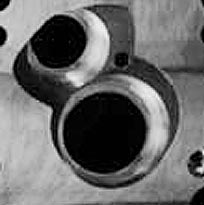 Mopar's new "Hemi"
head
Mopar's new "Hemi"
head |
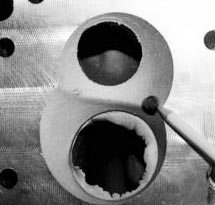 Sonny Leonard's
Chevy "Hemi"
Sonny Leonard's
Chevy "Hemi" |
"My motors would make as much or more power
as the Fords in cooler air, but in hot weather
the Fords and Chryslers had a horsepower edge,"
Sonny admitted.
In order to make his new engine a better air
pump he knew that he would have to have a more
efficient head. What he ended up with was a
cylinder head that combined the best properties
of the wedge combustion chamber with intake
and exhaust valves that were placed directly
in front of the intake and exhaust runners.
Placing the valves where he did in the head
provides not only a better path for the intake
charge but also a more efficient way to move
burnt fuel/air gases out of the combustion chamber.
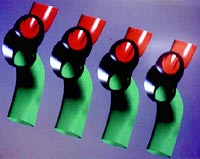 |
| CadCam
design of Sonny's combustion chamber |
|
The valves in his new cylinder head aren't
shrouded and the spark plug hole has been positioned
in the chamber to encourage more and better
flame travel. Better flame travel means more
efficient burning of the fuel-air mixture and
results in more horsepower and torque.
To ensure plenty of air volume and flow, the
head can have intake valves as big as 2.700
inches in diameter and exhaust valves as big
as two inches. According to Sonny, with a good
porting job, a .900-inch lift cam and a 2.550-inch
intake valve, the port will flow 590 cfm. The
exhaust port will flow 390 cfm with a 1.960
valve.
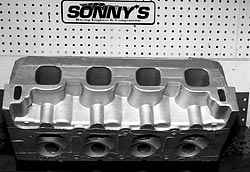 "In
testing we found that this engine will make
more horsepower at 20 cfm less airflow that
a comparable sized engine with our five-inch
bore center heads on them," Sonny said. "In
testing we found that this engine will make
more horsepower at 20 cfm less airflow that
a comparable sized engine with our five-inch
bore center heads on them," Sonny said.
This is more than just a high-horsepower engine.
This engine will live longer and has a broader
horsepower curve than the wedge-headed engines.
The Ford Hemi head has 10 9/16 studs. Sonny's
head has 22 1/2-inch studs necked down to 7/16"
studs for better load distribution. This will
help keep the head gaskets from pushing out
of shape when a racer adds massive amounts of
nitrous or runs a supercharger with 50 lbs of
boost.
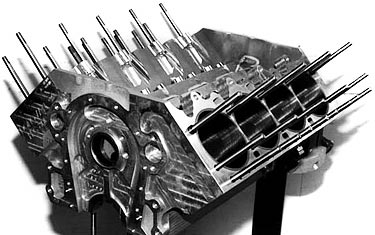 The
rest of the components that Sonny uses to build
this engine are the same track-tested components
he uses in all of his engines: Sonny Bryant
crankshaft, Bill Miller rods, Federal Mogul
rings, Venolia pistons, and Manley valves. The
rest of the components that Sonny uses to build
this engine are the same track-tested components
he uses in all of his engines: Sonny Bryant
crankshaft, Bill Miller rods, Federal Mogul
rings, Venolia pistons, and Manley valves.
While Sonny allowed us to take photos of cylinder
heads, blocks and rotating assembly components,
he was unwilling to reveal the exact info such
as bore, stroke, rod length, and other proprietary
information.

|